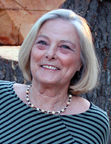K. Lang-Slattery's Blog, page 2
July 27, 2025
Creating a Book Cover that Works.
Marketing a book is probably one of the most difficult, complex, and challenging things a self-publishing author must tackle. An important component of the marketing effort is the book cover.
As readers browse shelves or scroll on the web, a book has only a few seconds to catch their eye and make them reach for it or click on it. As an indie author, I want a cover I can love, but I also need to make sure it grabs the kind of reader who will love the story I have written.
A striking book cover, like a good movie poster, needs to grab attention. It should be appealing, have eye-catching visuals, use colors that evoke emotions, ignite curiosity, and hint at what to expect from the story within. Besides the images and their arrangement, the style of typography can help convey the tone of the book and the genre. For example, stark, more contemporary, non-serif lettering is suited to thrillers, while script and curlicues work well with romance. Add to this, the need for a cover design to work in various sizes, including the small thumbnail usually seen first on digital book listings. Obviously, there is a lot to consider.
Creating a book cover is always (for me) a creative and collaborative project. Luckily, I have a wonderful designer, Cole Waidley, to help me. (cw******@***il.com) Cole and I both have an art education, but his is much more recent, by more than fifty years! I depend on his specialized graphic skills and understanding of computer-driven art applications to make the work go smoothly.
[image error]Before the actual design process begins, I send Cole a collection of files with information to inform and inspire him. For Ashes and Ruins, I sent him a brief book description, some photos (both my own and from stock photo collections), a selection of typical covers of published historical fiction novels, and a few ideas I envisioned. Cole took all my input, researched WWII and Blitz images available for free on stock photography sites, and created three “starter” designs. I was delighted to see that all of them featured my family photo of Edith (one of my story’s protagonists) embracing her husband.
Dozens of back-and-forth emails ensued. Mine usually began with “Can you add…?” “Can you change…?” or “Can you modify…?” or something of the like. Cole’s responses came back like clockwork—always with the requested suggestions beautifully implemented. Finally, we narrowed our choice to two:
1. A London scene with airplanes overhead and a romantic image in the clouds.
2. A collection of items from the story (the photo, a ration book, a stack of letters, a locket, and a bouquet of daisies) against a background of ruined, bombed-out buildings.
As my own publisher, I use a trusted circle of writers, friends, family, and my editor to gather initial input when I need fresh eyes on marketing issues. Their responses to the two covers were helpful, though their choice of a favorite was split right down the middle. Cole and I began another round of modifications based on my “team’s” feedback. As we worked, I got an additional idea. I asked Cole to create a cover that used the British and German flags as design elements.
[image error]He sent back a dynamic and visually impactful design. It hit all the marks except one. It did not convey the tone and content of Ashes and Ruins, a story of domestic and romantic life during wartime rather than a high-suspense war adventure. I wrote to Cole saying, “I may have to write a thriller so I can use this fabulous cover design!”
To add to the complexity, while waiting to see Cole’s next changes, I read an article on cover design. “Essential Elements of the Best Book Covers” published on The Write Practice website (thewritepractice.com), caught my attention. In the article, Vasylysa, who works with Miblart, a book cover design company, wrote, “The problem is that as the author, sometimes you’re focused on small story elements instead of the overall impression the cover gives your reader. Your cover needs to make a promise to the reader about what’s inside and what to expect without delving into details.” Her words really hit home.
Worried that our design with the assortment of items in the middle was exactly what Vasylysa was talking about, I asked Cole to simplify it. However, because the first “busy and detailed” version had been a test favorite, I’m still considering it. Thus, I am still looking at three choices! Two are similar, one less cluttered with detail than the other. But I love all three. How can I decide? What to do?
Which cover would most make you reach for this book, linger to read the description and review excerpts on the back, and maybe tuck it into your shopping cart?
A. London scene w/planes B. Ruins w/ration book C. Ruins w/photo & letters
[image error][image error][image error]The post Creating a Book Cover that Works. appeared first on Klang Slattery.
July 4, 2025
Finding the Women’s Story Buried in Immigrant Soldier
________________________________________________________________________________________
I was compelled to write my first novel, Immigrant Soldier, because the true story of my uncle’s role in Patton’s Third Army grabbed me and would not let me go. Herman’s Jewish blood branded him in Nazi eyes, forced him to flee his homeland, and landed him in the U.S. Army where he was trained to interrogate German prisoners of war.
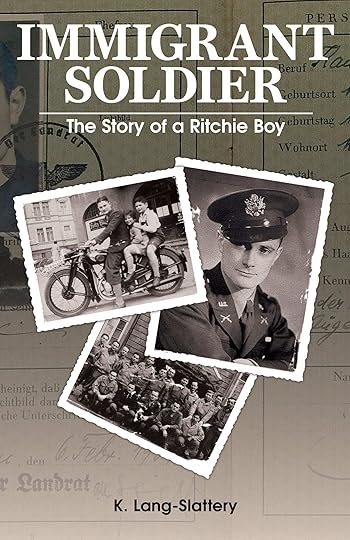
Though the story was gripping—a combination of a coming-of-age story, an immigrant tale, and a wartime adventure—I found that writing from the point of view of a young man was sometimes an out-of-body experience. As a woman in my late 70s, my experience of male emotions and attitudes came to me, at best, secondhand, from my father, various boyfriends, my husband, and my son. Writing about Herman’s days in the army was especially difficult because none of the men I knew well, except my son, served in the military, and he came back from Afghanistan and Iraq unwilling to talk about his experiences.
During the months I spent writing that first novel (ok, let’s be honest… the years!), the idea of writing a woman’s story always bubbled below the surface. The next book I wrote was indeed a story told by a woman, my own memoir, but thoughts of the women from Immigrant Soldier kept circling my mind. My grandmother Clara (Herman’s mother) and my aunt Edith (Herman’s sister) spoke to me, begging me to write about them.
I hesitated because I was unsure how to make their quieter story work as a novel. My two women relatives did nothing unusual in any big, heroic sense. They were not spies or resistance fighters, ambulance drivers, or code breakers. They did not suffer in concentration camps or hide in basements, sewers, or forests. Yet, I knew instinctively that they represented something important—women who waited, made do, worked hard, worried about their loved ones, and protected their children. They were the strength behind the heroes. I also have come to understand that in many small and quiet acts, Clara and Edith were heroes too.
One of the reader reviews for Immigrant Soldier carried, along with its kind words, a criticism of Herman’s mother. “I really didn’t like Clara,” the reviewer wrote, “because she stayed too long in Germany. Why didn’t she leave earlier?”
These words hurt in a visceral way and lingered in my mind. I wondered what I could do to help readers love Clara as much as I did. Perhaps if I explained more fully Clara’s situation and her reasons for lingering, readers could empathize with her choices. Like many other Jews who thought of Germany as their homeland, she had no idea that the slow increments of Nazi suppression and anti-Semitic legislation were leading to the horrors of Auschwitz and Treblinka. What we see now with clear hindsight was unimaginable to Clara in the 1930s.
Most of all, this story spoke to me as a mother blessed with a deep and strong relationship with my own daughter, a relationship that can (and has) weathered emotional ups and downs. Clara and Edith’s relationship, forged by their need to stand together, helped them endure amidst the turmoil of wartime. I would write of the losses and loves of a middle-aged woman, of her emotional depths, and of her mixed feelings as she watched her daughter journey from girlhood to a sexually awakened womanhood.
The evolving relationship between a mother and daughter, the incremental nature of anti-Semitic laws in Nazi Germany, and the quiet heroism of women on the home front would be my guiding themes. As the novel developed, I realized that PTSD and a woman’s right to choose, two issues with current significance, were also part of the story. These themes will, I hope, make Ashes and Ruins both universal and relevant to today’s readers.

This article originally appeared in my new Substack newsletter,
Wherever the Word Leads.
You can subscribe to the newsletter at https://kathrynslattery.substack.com/
or to my blog here on this website.
The post Finding the Women’s Story Buried in Immigrant Soldier appeared first on Klang Slattery.
July 2, 2025
Origins of a Novel

Every time I hold one of the silver spoons in my hand, I remember. My thumb strokes the simple design on the handle, the capital L and the flat, crossed ribbons. I admire the elegant shape of the spoon, and I remember. It is not even my memory. It is my grandmother’s.
I grew up with these spoons, stirring my hot chocolate with them, eating from the matching forks, and cutting my meat with the knives. I grew up with the furniture too. The round dining table that opened into a larger oval that barely fit into our tiny dining alcove. In my parents’ room, the set of beds with inlaid headboards and footboards nestled side by side to form one large, eiderdown-covered expanse that filled the room. Nearby stood a majestic dressing set with three tall, beveled mirrors and two marble-topped bureaus. In our living room, near the front door, place of honor was taken by what we called “the clock table” because of the matching clock with its sweeping shape and the large white face that helped me learn to tell time.
There was art too. I was fascinated by the drawing of a monkey playing the violin which my father proudly asserted was by a famous artist. In a corner near the door to our minuscule bathroom, a bronze sculpture of Mercury stood on display with his bow and quiver, his winged feet, and his muscled chest. The china cabinet was tucked in another odd corner because it would fit nowhere else. Behind the curved glass doors, safe from curious fingers yet easy to see, were more treasures—an elegant vase painted with lavender hollyhocks, a silver filigreed basket, and a cunning porcelain snail with a fairy riding on its shell. In the cabinets below, folded table linens, monogrammed with Ls like those on the silverware, were stored to be brought out for holiday dinners. A box at the top of my mother’s closet held old-fashioned ladies’ underwear, crocheted babies’ shirts, and a fine tulle wedding veil edged in lace.
These treasures, I was told, had traveled all the way from my father’s childhood home in Germany. How they had come to be in the two-bedroom beach cottage near the Pacific Ocean where I lived with my parents, my two sisters, and my grandmother was a mystery. The questions came later. Later still, when I was an adult, the truth of how these relics from a Jewish family had been spirited them away from Nazis who would have liked to keep them finally emerged.
Ashes and Ruins, a story of perseverance, courage, and strength during desperate times, grew from this family history.
____________________________________________________________________________________
If you like this article, please subscribe to this blog.
or follow my newsletter, Wherever the Word Leads. https://kathrynslattery.substack.com/
The post Origins of a Novel appeared first on Klang Slattery.
July 1, 2025
A Personal Space

· Do you love reading and books?
· Are you fascinated with WWII or the 1930s and 40s?
· Are you interested in the process of writing and publishing?
· Is travel your passion? Or reading about travel in your lounge chair?
· Do you like trying new recipes and eating exotic foods from around the world?
Yes, I know. This is a diverse list of interests and subjects for a single newsletter.
But that’s me. Katie Lang-Slattery: author, public speaker, Ritchie Boy and WWII-era specialist, traveler, cook, artist, gourmet and gourmand, book reader, friend, and mother. I like to think of myself as a Renaissance lady—a versatile, well-rounded person with various talents, areas of knowledge, and interests. My interests can carry me far afield, which is why this newsletter bears the title: Wherever the Word Leads, a nod to my travel memoir, Wherever the Road Leads.
If one or more of our interests coincide, please read my newsletter, and if you like what you read, please subscribe. It’s free!
https://kathrynslattery.substack.com
My plan is to post new material every week or so. I promise, no flooded inboxes!
______________________________________________________________________________________
My subjects will be broad. They may seem unrelated, but in one way or another, they all connect back to my novels and my memoir. I’ll cover everything from little-known WWII facts to book reviews, from my latest travel adventures to recipes, and from the process of writing to the joys and frustrations of self-publishing, as well as occasional reprints from past blog entries on my website or random items that catch my attention. Fact, fiction, my personal thoughts . . . you will find it all here.
Full disclosure: There will be regular updates about the editing and publishing of my current project, Ashes and Ruins, a historical WWII novel. Of course, I hope you will want to read Ashes and Ruins when it is launched this winter! Until then, I offer my newsletters and active blogs, including the newsletter articles.
More to come! Thanks for your support.
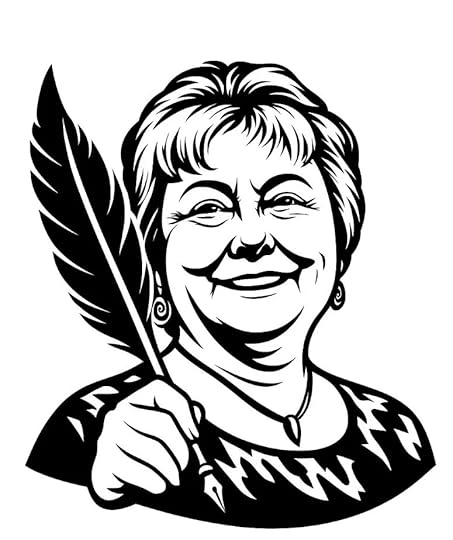
The post A Personal Space appeared first on Klang Slattery.
November 4, 2021
A Lifetime of Travel
In a previous blog I shared my collection of passports —a long line of documents that began when I was sixteen. These booklets, with their photos that reveal my gradually aging face and random visa stamps in red, green, and blue, represent a lifetime of travel. I also have a large box of travel journals, some on loose stapled sheets, some in the form of letters written home, and others neatly penned in bound journals and sprinkled with sketches. I treasure all these memory boosters.
Recently, I went through my collection and created a list of all the major travel experiences I have enjoyed in the last sixty plus years. The list includes all my travels that required a passport and a few significant stateside journeys. I’ve already written at length about my 2001 trip with my sister, Una, to India. A few of my other adventures may appear in future blogs. Do any of them spark your interest? Which ones would you enjoy reading about?
My Personal Travel Time Line
Summer 1960 – Europe with parents and 7-year-old sister, Karen
1966/67 – Graduate studies at University of the Americas, Mexico City, (inc. car trips to Yucatan and Acapulco) with Ron L.
Summer 1968 – East coast U.S.A. and cross-country drive on my own in VW van
Summer 1970 – Cross country car trip with Tom
September 1971 to September 1973 – “The Big Trip” in VW van with Tom, featured in Wherever the Road Leads.
October & November 1974 – Japan, Hong Kong, Malaysia, Singapore, The Philippines, and Bali with Tom.
March/April 1981 – Singapore (to meet Tom), Hong Kong, 3-day tour to Guangzhou, and meeting my mom and my 5-year-old daughter, Erin, in Hawaii.
October 1982 – Hong Kong cooking class and Hawaii, to meet my mom and Erin
 Feb. & March 1985 – New Zealand with Tom, Erin (age 9) and son Ethan (18 months old).
Feb. & March 1985 – New Zealand with Tom, Erin (age 9) and son Ethan (18 months old).
December 1989/January 1990 – Denmark with my sister Una, for a family wedding
Summer 1990 – Family motorhome trip to East Coast, including picking up our 4th Danish au-pair in New York and bringing her home with us through North Dakota, etc.
April 1991 – Germany with my parents and Una to visit my father’s hometown.
Summer 1993 – Family trip to Hawaii
October 1994 – England to meet Erin, and continuing Denmark to visit my nephew Mike.
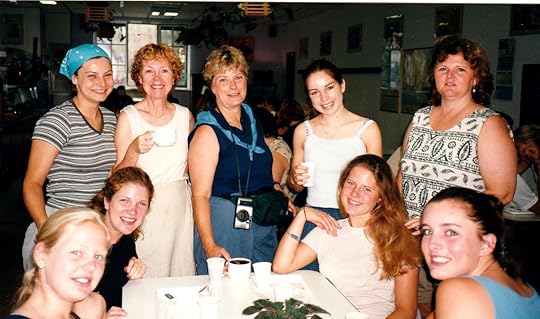
Summer 1998 – EuroPatrol. Leading teen Girl Scouts with three other adults, including Erin. Add to that a family trip with Tom, Erin and Ethan to Denmark to visit friends and relatives.
Spring – 1999 – New York City with a girl-friend.
February 2000 – England with Erin to interview my aunt Edith.

January 2001 – Elder Hostel to India with Una, plus train trip on our own to Girl Guide World Center in Patna. (See Return to India blogs)
April 2001 – Family trip to Hawaii
February 2002 – Girl Scout/Girl Guide trip to London with Erin, and a small group of leaders and one girl.
March 2002 – Elderhostel to China and Macau with Tom
February 2003 – Elderhostel train adventure in Australia with Tom
March 2004 – Chile with travel companion.
Summer 2004 – EuroPatrol. Leading teen Girl Scouts around Europe with Erin and another leader.
April 2006 – Chile with a travel companion.
September 2008 – Big Island, Hawaii with a girl-friend.
April 2009 – New York city with a girl-friend.
June & July 2010 – Northern Italy with a friend, Switzerland on my own, then join a Girl Scout patrol for a week and on to Denmark to visit my nephew Mike
April and May 2012 – Paris, the Dordogne, and Barcelona with a travel companion.
September 2014 – Home-exchange in Provence, France and road trip from Barcelona to Madrid with a travel companion.
April 2016 – Home-exchange in Brittany, France, and Road Scholar trip to Normandy and Brittany with a girl- friend.

April 2017 – Viet Nam with my daughter, Erin.
October 2017 – Milan, Venice, and House exchange in Paris with Ron (new partner, sculptor and illustrator of the Caitlin series of early-reader books.)
May 2018 – Sailing in Antiqua with Ron.
Summer 2019 — Car trip with Ron to Colorado and the Pacific Northwest to participate in art shows and visit my son Ethan.
* * * * *
In a few days I will be setting off on my first international trip since 2019. Two weeks in Belize—snorkeling, sailing, and swimming with my family. This is the first time I have planned an adventure that includes my adult children (my son Ethan, his wife Eva, and my daughter Erin). I will journal and sketch and take pictures….. and share this adventure with you when I return. Probably no new blogs posts until the New Year!
What journeys from your past stand out? After Covid, are you ready to travel again? And if so, beyond visiting family (which we all want to do), where do you want to go?
The post A Lifetime of Travel appeared first on Klang Slattery.
October 21, 2021
Balanced Memoirs of the Un-famous
Celebrity memoirs frequently appear on best seller lists, but what of the memoirs of the unfamous? If your name is well-known in the arts or politics, publishers will clamor for anything you might write. But, when a regular person with an interesting story writes a memoir, one of the first dilemmas they encounter is how to stand out in the market. What makes readers pick up the memoir of an unknown person, love it, and recommend it to a friend?
I usually prefer memoirs by ordinary people. One thing that makes a memoir like that resonate for me is the balance between the personal story and the special knowledge or experience the author shares. Below are a few of the more interesting memoirs I have read written by non-celebrities. 
In Sickness and In Health, by Karen Propp, 2002. This memoir is a love story about managing marriage during the illness of a partner. An extremely open and heartfelt writer, Propp shares the emotional rollercoaster of falling in love with a man recently diagnosed with prostate cancer. She deals with everything from raising a toddler during her husband’s treatments to her personal feelings and doubts. She also shares the the intimate efforts they try to resurrect their sex life. There is much to be learned about sustaining a marriage in this memoir, with or without the added issue of illness.

Come on Shore and We Will Kill and Eat You All, by Christina Thompson, 2008. This informative and insightful book balances memoir with historical and travel non-fiction. Thompson seamlessly blends her personal love story with the history of the colonization of New Zealand. She touches on multiple layers of understanding—everything from the attraction of the exotic, issues of marriage to someone of a different culture, her own New England background, the history of interaction between English colonists and the Maori culture, and the development of cultural stereotypes.
Paris Letters, by Janice MacLeod, 2014. The author shares her journey from busy ad executive in L.A. to strolling artist in Paris. Along the way she falls in love, gets married, and moves permanently to France. Told with humor and honesty and illustrated with lovely watercolors by the author, Paris Letters offers an intimate look at how to simplify a fast-track life to allow for a year abroad. MacLeod concludes with fun tips for saving or making $100 a day—a trick she used to set aside money for her year of travel. Her suggestions could be of value to anyone who wants save for a big expenditure.
ad executive in L.A. to strolling artist in Paris. Along the way she falls in love, gets married, and moves permanently to France. Told with humor and honesty and illustrated with lovely watercolors by the author, Paris Letters offers an intimate look at how to simplify a fast-track life to allow for a year abroad. MacLeod concludes with fun tips for saving or making $100 a day—a trick she used to set aside money for her year of travel. Her suggestions could be of value to anyone who wants save for a big expenditure.
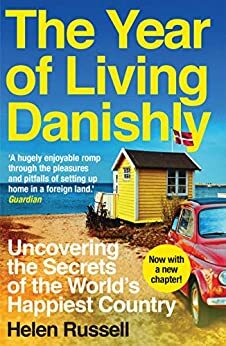
The Year of Living Danishly, by Helen Russell, 2015. Russell, a British journalist, writes about the year she and her husband lived as expats in Denmark. An unusual blend of narrative non-fiction and a laugh-out-loud, humorous memoir. Each chapter chronicles one month and deals with a different aspect of Danish life and culture told with the thoroughness of a professional journalist.
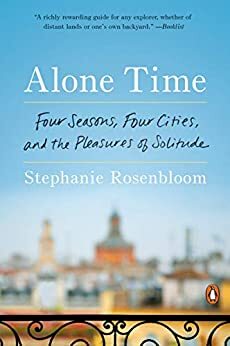
Alone Time, by Stephanie Rosenbloom, 2018. The author shares helpful tips, tools, and insights for solo travel balanced with delightful travel stories of Paris, Istanbul, Florence, and New York. A perfect book for anyone who would like to travel more, with or without a companion.
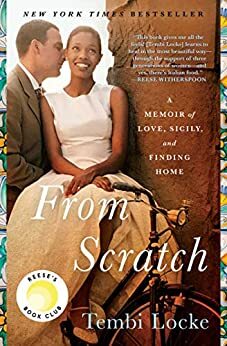
From Scratch, by Tembi Locke, 2019. Many distinct aspects make this memoir interesting. A black-American actress, Tembi falls in love with a Sicilian chef during her study year in Florence. She shares her deepest feelings about love, motherhood, working through her grief when her young husband dies of cancer, and getting to know her Sicilian mother-in-law in the small rural setting where her beloved grew up. Food and cooking connect the two women. Besides descriptions of simple meals, country cooking, and cheesemaking, Tembi also offers her readers the gift of special family recipes.
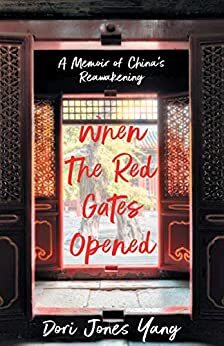
When the Red Gates Opened, A Memoir of China’s Reawakening, by Dori Jones Yang, 2020. This excellent memoir combines a personal love story with a journalist’s view of events in China in the 1980s. Stretching from the early days of China’s open-door policy to the Tiananmen Square crackdown, this book is perfect for any Sinophile. Yang lived through it all, wrote about it for BusinessWeek, all while falling in love and starting a family. Her love for China is obvious and forms the core of the story.
Baggage, Confessions of a Globe-Trotting Hypochondriac, Jeremy Leon Hance, 2021. This memoir shares the ups and downs of living with mental illness. It offers an interesting balance of nature travel and exotic locations with the author’s struggle with OCD, hypochondria, anxiety, depression, and a family history of mental illness.
A well-balanced memoir is like spending a long weekend talking with a friend or mentor. And it is this quality that can lift the memories of an ordinary person to an extraordinary level. I hope you will find my memoir, Wherever the Road Leads, an interesting balance of travel adventures and the ups and downs of a new marriage.

The post Balanced Memoirs of the Un-famous appeared first on Klang Slattery.
September 26, 2021
Travel Photos to Bring Back Memories
Travel photos can help you remember highlights of your journey long after you are home again. They can remind you of special experiences and people you met along the way. Nothing beats a significant photo for bringing back memories. Too often, travelers limit themselves to photos of tourist views and selfies taken in front of tourist views.
Taking pictures of a journey has been a hallmark of travel since the camera was invented. These magic boxes have changed a lot over the years. With a good smart phone taking quality pictures is easier than ever.
When Tom and I traveled in the van in the early 1970s, we carried a large SLR (single lense reflex) Pentax camera. We had bags of unexposed slide film and two camera lenses, one a twelve inch long telescopic. Tom loved taking pictures of local people using the telescopic lense because he could shoot from an anonymous distance. I also had a small, camera of my own to take snapshots.
 We soon found that getting film developed in places along the way was very expensive and time-consuming. The 24-hour film developers making their appearance in the US could not yet be found anywhere else. In Guadalajara, Mexico, where we settled in for a multi-week car repair lay-over, I had three rolls of my camera film developed. A note in our cost journal says, “$185.00 [pesos]- never again!” In 1971 dollars, this equaled the equivilent of US $100.00 today. At the 1971 exchange rate of 12.5 pesos to a US dollar, this would have been $14.80 US, enough at that time to buy 75 boxes of Kraft Mac and Cheese, about 400 eggs, or three restaurant meals for two.
We soon found that getting film developed in places along the way was very expensive and time-consuming. The 24-hour film developers making their appearance in the US could not yet be found anywhere else. In Guadalajara, Mexico, where we settled in for a multi-week car repair lay-over, I had three rolls of my camera film developed. A note in our cost journal says, “$185.00 [pesos]- never again!” In 1971 dollars, this equaled the equivilent of US $100.00 today. At the 1971 exchange rate of 12.5 pesos to a US dollar, this would have been $14.80 US, enough at that time to buy 75 boxes of Kraft Mac and Cheese, about 400 eggs, or three restaurant meals for two.
Two years later, when we finally had the film developed, there were hundreds of prints and slides to review. Sometimes the photos were not as beautiful as we wished. If they were badly framed, out of focus, or over exposed, retaking the shot was not an option.
These days it is a delight to look at digital photos immediately to check their quality. With a small, easy to use, smart phone, it’s easy to end up with great images.
However, the ease of modern digital photography seems to bring out a tendency to take tons of shots and sort them later. Have you ever looked at your travel photos and wondered, “Why did I take this?” Though views of famous landmarks or a selfie of you and your travel companions enjoying a late afternoon glass of wine are nice, consider finding subjects that go beyond the usual.
I like to create a series of photos that illustrates something that really fascinates me. I am a foodie, so I love to take shots of café meals or a still life of the groceries that will become a picnic. My favorite place to take pictures is at local outdoor markets. Piles of produce and condiments vary depending on the location and the season. Their vivid colors bring back mouth- watering memories.


 Do you love flowers? Why not take close ups of flowers you see along the way—
Do you love flowers? Why not take close ups of flowers you see along the way— anything from a display at flower shop to a lone daisy poking up between the stones of an ancient wall. Or perhaps, you are mad for purple. You could snap studies of every purple thing you see on your trip?
anything from a display at flower shop to a lone daisy poking up between the stones of an ancient wall. Or perhaps, you are mad for purple. You could snap studies of every purple thing you see on your trip?
Sometimes one item, even something a bit weird, can bring out cultural differences on a journey. When I traveled with teenage Girl Scouts around Europe in the summer of 1998, one of the girls took pictures of all the different toilets in the public restrooms she visited. They ranged from an old-fashioned squatter in a French village train station to a modern commode with its own plastic seat cover that automatically renewed after each flush.
Different travel destinations may call for different subjects as the lynchpin for memories. In Australia, I concentrated on images of eucalyptus trees—their silhouettes, their bark, leaves, trunks and flowers. Or, perhaps like me, you have very eclectic interests. Besides food, I always snap loads of pictures of flowers, country landscapes I want to paint, and local people going about their daily activities.
Some years ago, I discovered picture frames designed to hold a group of 4 or 5 “snapshot” size images in a row. They can be hung horizontally or vertically and are perfect for displaying a group of themed travel photos. Sometimes I add a small souvenir, like a coin or a seed pod, to one corner of the frame. Each grouping of coordinated photos reminds me of a different travel adventure and brings back pleasant memories.
“snapshot” size images in a row. They can be hung horizontally or vertically and are perfect for displaying a group of themed travel photos. Sometimes I add a small souvenir, like a coin or a seed pod, to one corner of the frame. Each grouping of coordinated photos reminds me of a different travel adventure and brings back pleasant memories.
What special item would make a good travel series for you? Cars? Cats? Doors and Windows? Store signs? Children? Water?

The post Travel Photos to Bring Back Memories appeared first on Klang Slattery.
September 10, 2021
Four Books about the Silk Road
For as long as I can remember, I have been fascinated by the Silk Road. Before adoption of the magnetic compass and advances in ship design in the early 1500s, this overland journey, also known as the Spice Road, served as the main trade route between China and Europe.
Visions of camel caravans crossing the dry deserts and snow-capped mountains of Central Asia captured my imagination. I longed to travel along this exotic route. I don’t know where my interest in the “Stans” (those mysterious countries along the Silk Road) originated. Was it my early interest in China, my first visit to Venice as a teenager, the exciting tales of Marco Polo, or Michener’s novel, Caravans, which I read in the mid-1960s?
As described in my travel memoir, Wherever the Road Leads, Afghanistan was a highlight of our two-year adventure. But Afghanistan, a turbulent nation now so much a part of our current news, lies south of the actual Silk Road. In 2001, Tom and I had signed up for an Elderhostel (Road Scholar) trip to Uzbekistan, Tajikistan, Kyrgyzstan, and Turkmenistan. We were to travel there after a trip to China. Unfortunately, the Silk Road portion of the trip was cancelled due to upheavals in the region. Uzbekistan was experiencing a build-up of US troops after 9/11 as the U.S. prepared to invade Taliban held Afghanistan. The tour organization deemed it unsafe to travel in the “Stans” and our opportunity was lost.
Recently, I have become an “armchair” traveler to Central Asia as I read four books about travel along the Silk Road.
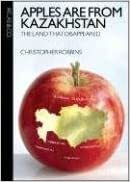 Last spring, my interest was rekindled by Apples Are From Kazakhstan, a travel memoir by a British journalist, Christopher Robbins. He became intrigued by Kazakhstan after an airplane conversation with an American on his way there to marry an Internet bride. In Robbins’ book, in-depth research is coupled with personal stories of his travels throughout Kazakhstan. The book fully discusses the country’s Soviet period, as well as the last 10 years as a democracy and its move toward modernization. Charming black and white wood-cuts by Bob Gale illustrate everything from yurts to eagles to oil wells.
Last spring, my interest was rekindled by Apples Are From Kazakhstan, a travel memoir by a British journalist, Christopher Robbins. He became intrigued by Kazakhstan after an airplane conversation with an American on his way there to marry an Internet bride. In Robbins’ book, in-depth research is coupled with personal stories of his travels throughout Kazakhstan. The book fully discusses the country’s Soviet period, as well as the last 10 years as a democracy and its move toward modernization. Charming black and white wood-cuts by Bob Gale illustrate everything from yurts to eagles to oil wells.
I’ve always loved reading books in subject matter groupings. This summer, I read the following books, one after another. If, like me, you enjoy reading about far-away lands, you might take a look at these.
Lands of Lost Borders, A Journey On The Silk Road, by Kate Harris, is the tale of the author’s bicycle journey (yes, you read that correctly — bicycle!) across China, Mongolia, Uzbekistan, Tajikistan and Kashmir. The author shares a story that discloses more than the discomforts of long, hot miles crossing the desert, painful saddle-sores, and sleeping in a tent or in third-rate guest-houses. Harris also discusses the history of the area, her interest in a variety of previous explorers (especially women), her personal reasons for preferring this type of travel, risky and illegal border crossings, and the look and feel of various towns and cities. Kate and her companion, Mel (her best friend from High School), sometimes resorted to loading themselves and their bikes onto cross-country trains, but mainly they pedaled the entire trip.
journey (yes, you read that correctly — bicycle!) across China, Mongolia, Uzbekistan, Tajikistan and Kashmir. The author shares a story that discloses more than the discomforts of long, hot miles crossing the desert, painful saddle-sores, and sleeping in a tent or in third-rate guest-houses. Harris also discusses the history of the area, her interest in a variety of previous explorers (especially women), her personal reasons for preferring this type of travel, risky and illegal border crossings, and the look and feel of various towns and cities. Kate and her companion, Mel (her best friend from High School), sometimes resorted to loading themselves and their bikes onto cross-country trains, but mainly they pedaled the entire trip.
The idea of riding a bicycle on such a torturous route sounds like a living nightmare to me. Still the book was interesting.
Stans By Me: A whirlwind tour through Central Asia – Kazakhstan, Kyrgyzstan, Tajikistan, Turkmenistan and Uzbekistan, is a memoir about a more conventional journey. 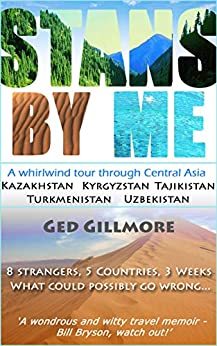 Ged Gillmore, a Brit turned Aussie, crime-fiction writer, recounts his story with a generous serving of deadpan British wit. After several days exploring Uzbekistan with a guide, Gillmore joins an organized tour, billed as “Five Stans in Ten Days.” Usually an independent traveler, Gillmore is terrified of joining a tour, but soon finds that the experiences he dreaded are perfect fodder for his humor.
Ged Gillmore, a Brit turned Aussie, crime-fiction writer, recounts his story with a generous serving of deadpan British wit. After several days exploring Uzbekistan with a guide, Gillmore joins an organized tour, billed as “Five Stans in Ten Days.” Usually an independent traveler, Gillmore is terrified of joining a tour, but soon finds that the experiences he dreaded are perfect fodder for his humor.
An enjoyable read, Stans By Me is a “once over lightly” tour of the region. Readers will share Ged’s joy seeing stark landscapes and ancient citadels, learn about still practiced rituals such as goat-pulling and bride-stealing, and visit bejeweled cities. At the end of the book, Gillmore inexplicably declares his memoir to be a novel. I think he changed the personalities, names and actions of his travel companions so much (for reasons of privacy and humor) that the memoir became, in his mind, fiction. The word portraits of Ged’s travel friends are lively and biting.
Sovietistan, longer than the others at 470 pages, is also arguably the best. The author, a Norwegian journalist, Erika Flatland, covers the five “Stans” in detail, one at a time. Each section begins with a map and a few statistics. Then Erika, writes in stunning prose about the overlapping history of each nation, as well as her personal experiences traveling there. I read the book in English, translated from the Norwegian by Kari Dickson.
Erika Flatland, covers the five “Stans” in detail, one at a time. Each section begins with a map and a few statistics. Then Erika, writes in stunning prose about the overlapping history of each nation, as well as her personal experiences traveling there. I read the book in English, translated from the Norwegian by Kari Dickson.
Flatland, who was trained as a social anthropologist, speaks eight languages, including Russian. Because the “Stans” were part of the Soviet Union from the 1870s until 1991, Russian is still spoken by many in region. Thus, Erika was able to interview local people herself, without the help of a translator. She describes the natural beauty, customs, economies, and political ups and downs of each country. Her extensive knowledge allows her to draw parallels and point out differences, but it is her story-telling ability that holds the reader’s interest page after page. Just when you begin to think you’ve had enough history and geography, Erika offers a glimpse into a remote valley or a local festival. When the author talks directly to people along the way, wonderful insights into their personal lives and day to day struggles emerge.
One of these fascinating chapters deals with the tradition of bride-stealing, still routinely practiced in Kyrgyzstan. Even modern, educated, young women starting careers in the city are kidnapped by men from the villages. This endeavor is supported by the boy’s family and friends, often even by the family of the girl. Though outlawed, the practice continues and few girls have the will to resist. They know they will be ostracized if they do. Certainly, this women’s rights issue needs more western exposure.
After reading so much about Central Asia recently, I still long to go there. But now, my enthusiasm is tempered by additional knowledge. I have a better idea of where I would want to go and which cities or countries I might choose to skip. Unfortunately, I feel this may be a trip more for the young than for a traveler who is rapidly approaching eighty. But, I can still dream. For the time being I will remain an armchair-traveler to the “Stans.”
What is the dream trip you long to take? What is your favorite arm-chair travel destination? Please share your answers in the “Leave a Reply” form below.
The post Four Books about the Silk Road appeared first on Klang Slattery.
August 27, 2021
On the Hippie Trail with Two Brits
Some time ago, John found me through my web-site and emailed me in response to my interest in stories of about the Hippie Trail overland to India. Recently, he and I visited on Zoom. His story follows.
* * * *
 On Christmas Eve in 1968, John and Brian, sat in the Hazel Pear pub in Cheshire, England. They raised foaming pints, and talked of what the coming year would bring. Though both young men had recently established respectable careers (John was a Chemical engineer and Brian a Solicitor), they discovered a mutual desire to make a change and do some extended traveling.
On Christmas Eve in 1968, John and Brian, sat in the Hazel Pear pub in Cheshire, England. They raised foaming pints, and talked of what the coming year would bring. Though both young men had recently established respectable careers (John was a Chemical engineer and Brian a Solicitor), they discovered a mutual desire to make a change and do some extended traveling.
“Let’s do it,” John said. “Where shall we go?”
Like many Brits, the two mates first considered somewhere that was part of the broad expanse of the British Commonwealth. “We could go to Canada, but Australia is further and the journey would be more interesting,” posited Brian.
Soon they had made a plan to drive overland to India the following autumn and travel by boat on to Australia. In the Hazel Pear, an adventure was born.
John and Brian bought a ten-year-old, left-hand drive Mercedes sedan (an odd thing to find in the UK where right hand drive is the norm). They named it “The Royal Wave” because friends commented that the car seemed quite regal. Brian had a late August social commitment in France, so John was at the wheel for the first test drive from Wales to Le Havre, where he picked up his mate. By the 3rd of September, the friends were in Switzerland and heading toward Italy and Yugoslavia.
Just south of Dubrovnik John’s prize travel purchase, a primus stove fueled by regular petrol, revealed its tendency to erupt into a flame-thrower. After inspection and cleaning of the non-return valve, the stove was tamed and served well for many more months. John told me during our Zoom conversation, that the cooker brought them instant popularity at the tedious queues at border crossings. They would set up the stove, boil water in their kettle, and offer hot tea to other travelers.

As Tom and I experienced in 1972, the long trek overland to India along the Hippie-trail was always a series of adventures. For a detailed account, of John and Brian’s trip check out John’s web-site at Overland Home (johndefig.net) His memories, like mine are helped by his travel diaries.
Tom and I knew that many Hippie youth who traveled the road sold their blood as a way of augmenting their finances. Luckily, we never needed to do this. However, I was surprised to read that John gave a pint of blood in Athens in exchange for five English pounds.
The British friends made the regular stops along the way—Athens, Istanbul, Ankara—to Tehran. Similar to Tom, John was a good mechanic and was able to make most needed repairs to The Royal Wave along the way.
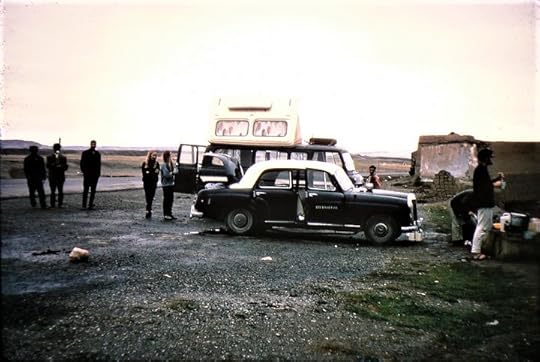 In the Iranian capital, John and Brian settled into a cheap hotel. “Really more of a back-packers hostel,” John told me. They arrived in time for a public holiday celebrating the Shah’s 50th birthday. The mates hoped to find temporary work in Tehran. In between job hunting, they made friends with other travelers at the hostel. Little work could be found other than short gigs tutoring English conversation. Their travel funds were dwindling faster than they had expected. Heinz, a German resident at the hotel who was full of ideas, suggested they sell the Mercedes. He was sure he could find a buyer and he did.
In the Iranian capital, John and Brian settled into a cheap hotel. “Really more of a back-packers hostel,” John told me. They arrived in time for a public holiday celebrating the Shah’s 50th birthday. The mates hoped to find temporary work in Tehran. In between job hunting, they made friends with other travelers at the hostel. Little work could be found other than short gigs tutoring English conversation. Their travel funds were dwindling faster than they had expected. Heinz, a German resident at the hotel who was full of ideas, suggested they sell the Mercedes. He was sure he could find a buyer and he did.
With the influx of cash (a few dollars more than they had paid for the car) and some fancy document footwork including mysterious Farsi writing on John’s passport, the two friends became bus travelers. John is fairly sure they joined a bus group mentioned in Sharif Gemie’s book, The Hippie Trail. (see blog: Hippie Trail Adventures – Klang Slattery) “A Safaris Overland coach [that left London] . . . October 1969 had 15 women and 10 men,”(The Hippie Trail; Gemie, Sharif; Ireland, Brian; 2017; pg. 73) a ratio that was changed when Brian and John boarded.
The Safaris Overland bus offered travel well below the luxury threshold. Besides basic seats, over-night sleeping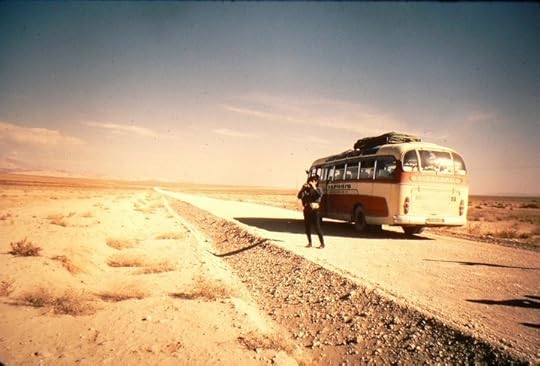 arrangements were a free-for-all. Each evening, the bus would try to find a cheap hotel. Some of the passengers rented rooms, but others stayed in the bus and slept across the seats or on the floor. John told me he could often be found sprawled in an open space just behind the driver’s seat. Soon the passengers became, if not friends, at least cohorts and companions. One of the women passengers was a young, Latvian born, Australian raised, school-teacher named Inta. John and Inta soon formed a romantic attachment slowed down only by her plans to return to Australia by plane from Delhi. (John and Inta later married in Australia, a union that lasted for twenty-five years.)
arrangements were a free-for-all. Each evening, the bus would try to find a cheap hotel. Some of the passengers rented rooms, but others stayed in the bus and slept across the seats or on the floor. John told me he could often be found sprawled in an open space just behind the driver’s seat. Soon the passengers became, if not friends, at least cohorts and companions. One of the women passengers was a young, Latvian born, Australian raised, school-teacher named Inta. John and Inta soon formed a romantic attachment slowed down only by her plans to return to Australia by plane from Delhi. (John and Inta later married in Australia, a union that lasted for twenty-five years.)
The bus ticket covered getting to Northern India and several side trips, including Kashmir, Jaipur and Agra, with the final stop in Delhi. Some of the passengers convinced the driver to take them as far as Calcutta (Kolkata). Our two friends went along on this jaunt, but returned to Delhi with the driver.
The cheapest way to get to Bombay (Mumbai), where they had connections to family friends, was by third-class train. Though they had seat assignments for the overnight trip, the accommodations were spartan. The two Brits shared an open, sleeper compartment with a group of two old ladies and three girls, including one very pretty young woman in a sari. Besides more people than bunks (two women shared one bunk), the compartment floor was piled with luggage: a huge tin trunk, three smaller trunks, four bulky bedrolls, hand-luggage, not to mention the backpacks of the Brits.
The train traveled south, across the high, dry plateau of central India. Luckily, food was available. A surprisingly good evening meal of soup, fish, bread and fruit arrived (yes, served by a train employee) around 8:00 in the evening. At one of the stops, another woman and her “bearer,” an old man shouldering two giant bedrolls, boarded the train. They claimed the last two bunks. After dinner, everyone spread out their bedrolls. In his web-site diary, John writes, “We soon realized why they [their Indian companions] had these huge bedrolls. In the third-class sleeper, the bunks are made of wooden slats. A thin sleeping bag provided virtually no padding. . . Compared with sleeping on the floor of the bus, the wooden slatted bunks on the train were comfortable.” The next day proceeded with breakfast, a lunch of mutton chops, afternoon tea, and naps. The entire trip from Delhi to Bombay took about twenty-four hours.
John and Brian enjoyed two weeks in Bombay feted by their local friends over the Christmas holidays. Getting to Australia by boat as they had planned turned out to be very complicated and expensive. Finally, they opted to fly from Bombay to their final destination. (In Wherever the Road Leads, I describe a similar experience trying to get across the Darian Gap in Panama.)
John planned to stay in Australia for at least two years, but from the beginning, he knew he might choose to stay there. His marriage to Inta sealed the deal. When I spoke to him last week, he sat in a sunny window nook in his home near Melbourne where he lives with Judy, his second wife. Though he worked as a Chemical engineer his first year in Australia, John soon had the opportunity to become a physics instructor at the same private high school where Inta taught. John a high school teacher for twenty-five years. Later, for a further thirteen years, he served as a staff trainer and on-line system administrator at the college level. He continues to travel and explore the world, first with Inta and later with Judy.
These days, John travels towing a caravan (trailer). He and Judy love going to the Australian outback where they offer their services teaching children who live on remote cattle stations.
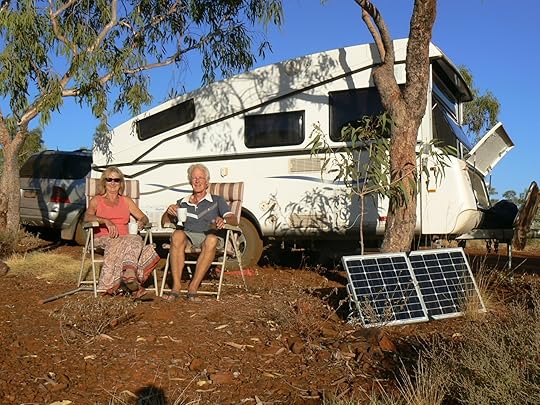
The post On the Hippie Trail with Two Brits appeared first on Klang Slattery.
August 12, 2021
The Ultimate Road Trip Memoir
In 2007, Dina and Bernard joined the Centennial Beijing to Paris Motor Challenge, a 36-day car rally that would stretch for 9316 miles across the Gobi desert, Siberia, Russia, and eastern Europe.
Married for twenty years, the couple had owned and operated a successful business together. In 2005 they were living on a ranch in Colorado, bailing hay, fixing fences, and horseback riding in the sunset. At a local event, they learned about the motor rally and quickly decided to enter. They had a lot to learn and a car to purchase, but they would do it together.
Dina describes herself as a worrier who can easily imagine the worst. Yet she is also a romantic who loves the idea of adventure. She hates the unknown, is prone to car-sickness, and knows horses, but not cars. Bernard, a transplanted Frenchman, is a man who loves cars, can fix them, and thrills at driving fast. He meets problems with calm, rational thinking. Naturally, Bernard would be the driver and Dina would be the navigator. Neither of them had ever participated in a car rally before entering the Beijing to Paris sponsored by the Endurance Rally Association.
Dina’s memoir, written several years after the adventure, describes the ultimate Road Trip. Peking to Paris, Life and Love on a Short Drive Around Half the World, is a delightful read from start to finish. Full of anecdotes, the memoir is as much about romance and marriage as it is about travel adventure. Dina’s voice is honest, lightly humorous, and self-deprecating. 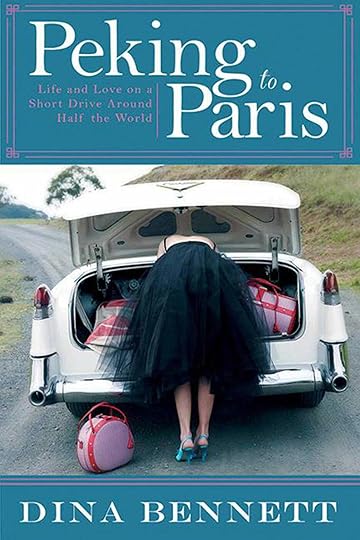
There was so much in Dina’s story that rang true and familiar to me. Bernard, like my husband Tom in Wherever the Road Leads, was a genius at repairing their car, a 1940 GM La Salle two-door coupe. Dina describes the pleasure of helping just enough to understand what Bernard was doing and to appreciate the challenges of road-side repairs. Like myself, she had romantic notions of what might happen on the trip, but soon learned to accept the day-to-day stress of keeping the vehicle running. And Bernard was willing to help her live some of her romantic dreams when the trip allowed. Between car repairs, there were bad roads, an engine prone to over-heat, border crossings that took all day, making friends along the way, and occasional breaks to enjoy local food at a roadside cafe.
For me, the rules and traditions of the endurance road rally were a fascinating look into a totally different kind of road-trip. Dina clearly described the need to keep to a schedule, to show up at the starting gate each morning at their assigned time, to check in along the way each day and at the delegated lay-over each night. So much of the rally was completely different from a normal road trip.
Intermittent time-trials added excitement to some stretches. In the Gobi Desert, sand storms and dirt tracks that disappeared into nothingness added their own suspense.
A sense of community developed among the drivers and navigators and at the end of the day, over a drink, they often shared stories of their tribulations along the road. The more experienced rally participants freely shared their knowledge with Bernard and Dina. On the first evening in Beijing, one lady taught Dina, a complete novice, the basics of the duties of the navigator. The men loaned each other tools and even, on occasion, car parts. Participants waved signs that said “We’re OK” or “Need Assistance” when they stopped along the route.
Dina has added a series of appendices at the end of her memoir, including statistics about the rally and rally terminology.
If you enjoyed my memoir, Wherever the Road Leads, you’ll love reading Peking to Paris by Dina Bennett
Peking to Paris | A memoir of the Peking to Paris classic car rally (dinabennett.net)com: Peking to Paris: Life and Love on a Short Drive Around Half the World (Audible Audio Edition): Dina Bennett, Katherine Dyer, Audible Studios: Audible Books & Originals
Endurance Rally Association – Home | Endurorally
The post The Ultimate Road Trip Memoir appeared first on Klang Slattery.

